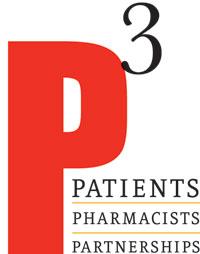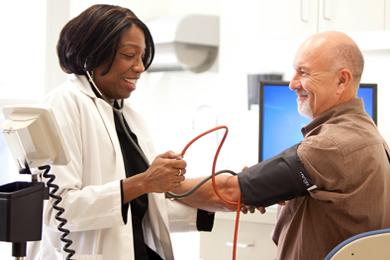SOP Program Cited As National Model for Patient-Pharmacists Partnerships
A recently published program guide from the CDC highlights the efforts of the Maryland P3 Program to expand pharmacists’ role in team-based health care.
By Malissa Carroll
December 3, 2012
Earlier this year, the Centers for Disease Control and Prevention (CDC) published A Program Guide for Public Health: Partnering with Pharmacists in the Prevention and Control of Chronic Diseases. This guide, aimed at CDC grant recipients, encourages health care providers and organizations to build relationships with pharmacists and features the Maryland Patients, Pharmacists, Partnerships (P3) Program at the University of Maryland School of Pharmacy, in collaboration with the Maryland Pharmacists Association (MPhA), the Maryland Department of Health and Mental Hygiene (DHMH), and self-insured employers, as a national example of how pharmacists can partner with other health care professionals to make a difference in patient care.
“Receiving this recognition from the CDC underscores how the School of Pharmacy, the state of Maryland, the Maryland Pharmacists Association, and the Maryland P3 Program continue to shape the scope of pharmacy practice locally and nationally through the incorporation of pharmacists in the health care team,” says Magaly Rodriguez de Bittner, PharmD, CDE, FAPhA, professor and chair of the Department of Pharmacy Practice and Science and director of the Maryland P3 Program “Our practitioners continue to pioneer new roles for pharmacists in advanced clinical practice and remain committed to a continued partnership with community, institutional, and long-term care pharmacies throughout the state and nation.”
Acknowledging pharmacists as experts in the use of medications to optimize patient drug therapy, the CDC notes that these practitioners are also the most accessible members of the health care team. They provide direct patient care to ensure that medications are used in a safe and effective manner.
To illustrate the wide range of patient care services that pharmacists can provide, the guide refers to the Maryland P3 Program as an example of how pharmacists can partner with other health care providers and organizations to offer comprehensive medication management to improve chronic disease-related health outcomes. The program, which uses trained pharmacists to assist patients with proper use of medications, diagnostic testing, counseling, and overall disease management, was highlighted for its work supporting pharmacists’ collaboration with other health care providers to improve medication adherence and clinical and economic outcomes.
Though there are a number of programs across the United States designed to encourage health care providers and organizations to develop relationships with pharmacists, the CDC only featured two such programs in its guide, including the Maryland P3 Program.
“By becoming active participants in chronic disease management through team-based care, pharmacists in the Maryland P3 Program are proactively working to change pharmacy practice and advocate for payment reform,” says Rodriguez de Bittner, who also served as a contributor to this guide. “This innovative program has taken root and grown throughout the state and beyond because it enhances the continuity of care in the health systems in which it operates and provides data that supports the value of the pharmacist on the team.”
Many state health departments had no experience working with pharmacists in team-based care when the CDC began work on the guide earlier this year. Following the publication of the guide, the agency observed a substantial increase in interest among health care providers and organizations wanting to partner with pharmacists to deliver patient care. The significance of this guide for pharmacy practice was also featured in an article from Pharmacy Today, a publication of the American Pharmacists Association (APhA).



